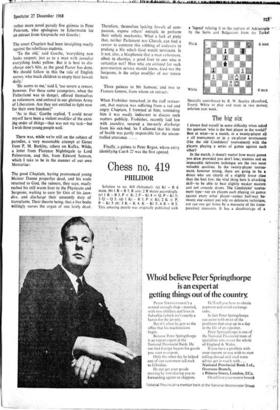Chess no. 419
PHILIDOR
Solution to no. 418 (Schumer): (a) Kt – B 6 mate. (b) I R– B 7, R any; 2 R mates accordingly. (c) I R – B 3, P R; 2 P – Kt 8 = Q, P – Kt 5: 3 Q – Q 5. (d) I Kt – B 3. P x Kt; 2 K x P, P – Kt 5 ch; 3 K – K 4. K – Kt 5; 4 R – B 5. This amusing puzzle was originally published with a 'legend' relating it to the capture of Adrianople by the Serbs and Bulgarians frum the Turks!
Black 8 men
Specially contributed by R. W. Searley ( R omford, Essex). White to play and mate in two moves; solution next week.
The big six
I always find myself in some difficulty when asked the question 'who is the best player in the world?' Best at what—in a match, in a twenty-player all v all tournament or in a six-player tournament (like the old Candidates' tournament) with the players playing a series of games against each other?
In the match, it doesn't matter how many games you draw provided you don't lose; stamina and an impeccable defensive technique are the two most valuable qualities. In the twenty-player tourna- ment; however strong, there are going to be a dozen who are clearly of a slightly lower class than the best few; the vital thing here is attacking skill—to be able to beat slightly weaker masters and not concede draws. The Candidates' tournar ment type—say six players each playing six games against every other player—comes half-way be- tween; one cannot just rely on defensive technique, nor can one get home by a massacre of the (com- parative) innocents. It has a disadvantage of a dtift• ,:nt type in choosing a challenger for the title that if (as at present) there are several players of he same nationality, they get some advantage for this and (in theory, though this has not happened in practice) they could combine to squeeze out a 'foreigner.'
Still, intrinsically I think this is the best test and it is the one I propose to adopt. Who are the six best players and in what order would they finish in such an event?
First, some figures. In Professor Elo's rating which assesses players on all the games played from January 1966-April 1968 taking into account the strength of their opponents the top nine in order are: I, Fischer (usA); 2, Botwinnik (ussR); 3, Korchnoi (USSR); 4, Spassky (ussR); 5, Larsen (Denmark), Pctrosian and Tal (ussR); 8, Geller and Smyslov (USSR). For various reasons, I think that Geller and Smyslov are slightly weaker than the others and Tars uncertain health pulls him down; no one below these nine has a real claim, so we have Fischer, Botwinnik, Korchnoi, Spassky, Larsen and Petrosian. Botwinnik plays less than the others and not in the hardest tournaments; I don't think that now he would stand the strain of a really severe event. Fischer, Korchnoi and Larsen are all 'killer' types, scoring very heavily by slaughtering the average grandmaster-Fischer is the best, probably, of the three, but even he has a poor record against the great Soviet masters. Petrosian-lazy in the ordinary tournament-has shown in beating Botwinnik and Spassky in twenty- four game matches how he can rise to the occasion; but his poor tournament record must count against him. Spassky-with decisive recent wins in matches against Korchnoi and Larsen-has only the narrow defeat by Petrosian against him: a little too peace- ful against weaker players he raises his game, when he has to, in impressive style.
All in all, my order is: 1, Spassky; 2, Fischer; 3. Petrosian; 4, Korchnoi; 5, Larsen; 6, Botwinnik; and I would expect a perceptible gap between the first three and the last three.



































 Previous page
Previous page